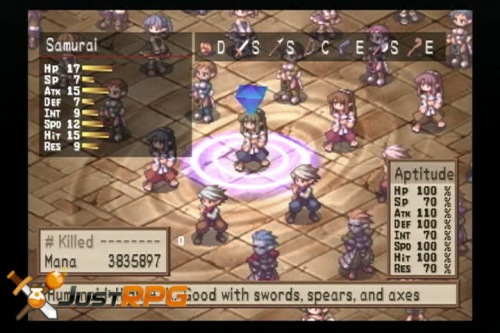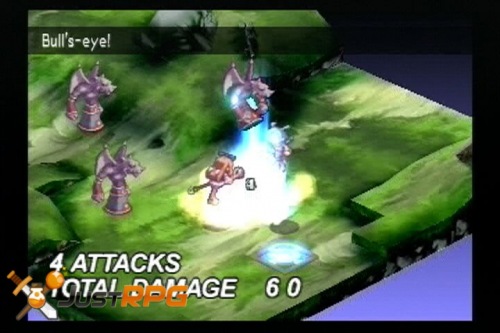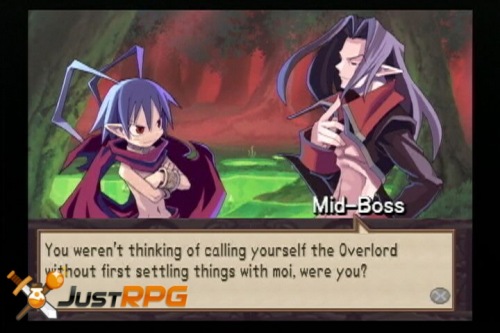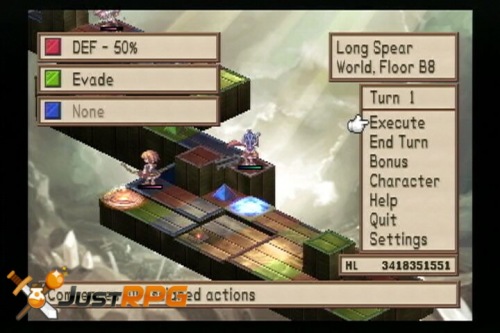Disgaea: Hour of Darkness
Disgaea: Hour of Darkness is an innovative strategy RPG with anime inspired visuals, an original story line, and hundreds of hours of gameplay value. Explore the netherworld while deploying up to 10 characters in turn-based battles that take place on gridded maps.
| Developer: Nippon Ichi Software Publisher: Atlus Release Date: September 25, 2003 Platforms: PS2 JustRPG Score: 96% Pros: +Attractive art style. +Great voice acting & story. +In-depth gameplay. +Plenty of side-quests and additional content. Cons: -Slow paced gameplay. -Steep learning curve. |
Disgaea: Hour of Darkness Overview
Disgaea: Hour of Darkness combines the classic turn-based gridded strategy RPG gameplay style and combines it with a quirky story, and well drawn visuals. The main story is divided into chapters, but there are tons of side quests and other activities to keep players occupied for hundreds of hours. Enlist dozens of characters and enlist up to 10 at a time in battles that take place on gridded maps. Due to its attractive art style and great presentation, Disgaea quickly gained a cult following that spawned several sequels and ports.
Disgaea: Hour of Darkness Screenshots
Disgaea: Hour of Darkness Featured Video
[youtube]http://www.youtube.com/watch?v=osTt0bITx7U[/youtube]
Disgaea: Hour of Darkness Review
By, Patrick Mansfield
When a game claims that “Strategy RPGs are about to get a serious kick in the ass!”, either the game will be a big disappointment, or in Disgaea’s case, it delivers what it promised. Disgaea is easily one of the top RPGs of the year, and one of my new favorite games.
After awaking from his two year slumber, Prince Laharl finds that his father King Krichevskoy, ruler of the Netherworld, has died. With the King dead, demons from all over the Netherworld are now vying for the throne. Laharl begins his quest to rid the opposition and gain his right as heir to the throne.
Of course, that is a brief look at Disgaea’s great and very humorous storyline. The story unfolds in numerous voiced scenes, which provide an excellent feel for the characters and their emotional tones. Disgaea is also broken up into chapters, which all end with a humorous, anime-style “preview” of the next chapter. Speaking of anime, Disgaea’s English voice work is well done (although it can get kind of annoying with certain characters) and the characters’ voices match them very well. In addition to the English voice work, there is the option to enable the original Japanese voice work.
Despite this being the age of 3D and polygons, Disgaea’s graphics are wonderful and suit a game of this nature. Of course, the battlefields are 3D, but the characters, who I am more concerned about, are done with 2D sprites. The sprites, in my opinion, are more suited for a game like Disgaea because of their fluidness and artistic qualities, and they lack the ugliness of some polygons (no blocky figures), and the amount of action in battle would be too much work for polygons and would end up looking poor. They also give Disgaea a cartoonish feel, which I think complements the game’s humor. I personally have no problem with Disgaea’s simple graphics and think that they have been well done.
Although Disgaea’s gameplay has been seen before, in Square’s Final Fantasy Tactics and Atlus’ own Tactics Ogre, it has a very distinctive feel so fans of the genre (e.g. Like me) will not get bored and people new to it will have much to enjoy. Controls are hardly a problem, since the game moves at your pace, since there is nothing that requires speed or skill in button pressing, just move the analog/digital and hit buttons when you need to, so it is not complicated for your hands. The battle system is setup much like chess, except there are different heights, and you move your characters along the board. Upon reaching an enemy you can select either to attack, use a skill, or you can pick them up and throw them. Once an action is selected, you can move on and continue moving your characters into battle, execute all current actions and then continue on, or end the turn, which executes all actions and then it’s your enemy’s turn. When selecting these options you must consider the impact it will have on battle. After dispatching an enemy you will gain Mana, which will be of use in the Dark Assembly, explained later.
As mentioned earlier your actions are not limited to your enemies, but rather they can be used on your allies, such as throwing an ally into battle where he/she could not get to without aid. Certain skills and attacks, however, do not require being adjacent to your target, but rather within a range, and most attacks will not function if there is no target or if certain areas are too high/low or blocked. The team element is a big influence in battle, other than throwing; there is double, triple, and quadruple teaming your enemy. The way it works is simple, an attacker’s allies can be placed at his sides and behind him, while he is attacking the enemy in front of him, your characters will attack in unison, however, this is based on percentages, of how well they work together. Adding to more tactical warfare is that, although I find it kind of unfair, since the aiding allies do not suffer anything from helping, they can be moved back to their original positions and go on to do more battle. My best example is this, an ally can be moved within healing range to get healed, then the action is executed, then he can be moved back to the original point and help out with an attack, execute the attack, after that, moved back and attack another enemy. Unfairness aside, this makes a rather difficult battle much easier, if used correctly.
Along with using your team to your advantage, you will have to utilize the map as well. On some maps, there will be different colored tiles, which can provide bonuses and negatives. The way they are decided is if one of the colored tiles has a small, colored pyramid on it, which can be lifted and put on another color, or destroyed. For example, a green pyramid is destroyed on a blue tile, all of the blue tiles on the map will be changed into green, also resulting in damage to whatever is standing on the blue tiles. This feature also allows for control over battle, sometimes allowing you to finish a battle with minimum effort.
The final keys to battle are both weaknesses to Disgaea’s three elements and status effects, and end of the battle bonuses. Disgaea has only three elements, Wind, Water, and Fire, but most characters have weaknesses to at least one of these, and the five status effects, which allow you to easily choose the right magic to be used on the enemy. Status effects, as well as elemental attacks, can be negated by equipping the right items or even having the right residents inside, which will be explained later. Finally, as the battle progresses a bonus meter is filled up, depending on the tactics used, and how you fare in battle. At the end of the battle the bonus meter is emptied and you are awarded both Hell (the unit of currency in Disgaea, abbreviated HL) and prizes based on the level you get to on your bonus meter. The bonuses can be anything from more HL, to experience points, and items.
When you’re not fighting enemies or laughing at the conversations, you’re inside Laharl’s castle, which is not very big, but it has everything that you will need in the game. First it has both an Armor/Item shop, and a Weapon shop. As you buy items at the shops your customer rating goes up, allowing you to get better items, which will be explained later. Items are particularly humorous, to say the least, in Disgaea, most items have either funny names, or funny descriptions. Aside from the shops, there is a hospital, where you can revive, heal, and cure your team, for a price, and the resident nurse urges you to get hurt in battle. Although it does cost HL, after frequent visits to the hospital you are able to claim prizes, most of which are actually good, or better than what you can find in the shops. Next to the Hospital is the Item World, where you can travel inside your items to both level up that item, and free the residents, who power up certain attributes of your items, inside to do your bidding. Once they are freed, they can be moved from item to item allowing you to power-up any weapon you want, albeit certain weapons only have limited space. On a humorous note, all of the residents, also called specialists, have names that correspond with what they power up, such as Dietician to increase your health, or Social Worker to increase your resistance to the Deprave status effect.
Besides the Gateway, which will take you to most of your story battles, there is one last place to go in the Castle, The Dark Assembly. The Dark Assembly is basically the Netherworld’s form of Congress, where you can do all sorts of things. Creating new characters is one of the DA’s most useful features, since it allows you to add new and more stronger allies to your team, although they are at Level 1. To make a character you must first have Mana, which as mentioned earlier comes from killing your enemies, also an important note is that unlike HL every character has their own Mana source so they have to see battle to be able to be helpful. After you have made a character you can delete them or change their name, or even fight in a battle to promote your “Demon Rank.” Although some of the battles are tough, getting a higher rank will allow you to have more influence of the DA, improving your chances of getting what you want from the Senators of the Dark Assembly, such as more money by extortion, higher priced items in the shops, or even send your character back to Level 1, called transmigration. You’re asking yourself why would someone want to do that? Simply put, it allows your character to become even stronger, depending on how much Mana you have, you can transmigrate your character with certain percentages of inheritance, obviously the higher the percentage the higher the Mana cost. Now, some of your actions will require approval by the DA, and your influence may not be enough, that is why you have the option to give the Senator a “gift,” better known as a bribe. Once you are done giving “gifts” you will allow the Dark Assembly to vote, should you lose you have the option of giving up, or helping them decide otherwise, by force. Normally, early on in the game this is not a good idea, since the Senators are much more powerful than you, such as my Level 43 character against a Level 237 Senator.
Digging deeper into Disgaea, the music and sound come very apparent. Both are accomplished well, however, they will not win any awards for greatness. During battle, certain battle sounds, and catch phrases like “I’ll finish this!” or “Punk!” will get repetitive. The music, on the other hand is less repetitive, except for Laharl’s Castle music. There is even a song from a Punk-Rock band called Tsunami Bomb, called Invasion from Within (to hear it and watch a video of Disgaea head to Atlus USA’s website).
Said simply, Disgaea is one of the best new PS2 RPGs on the market. I recommend it strongly to fans of the Strat/RPG genre and encourage other players to come and experience this great game, since a game this caliber only comes around every so often.
Disgaea: Hour of Darkness Screenshots
Disgaea: Hour of Darkness Videos
Disgaea: Hour of Darkness Official Trailer
[youtube]http://www.youtube.com/watch?v=osTt0bITx7U[/youtube]
Disgaea: Hour of Darkness Intro
[youtube]http://www.youtube.com/watch?v=1os9PMnxNNA[/youtube]

















